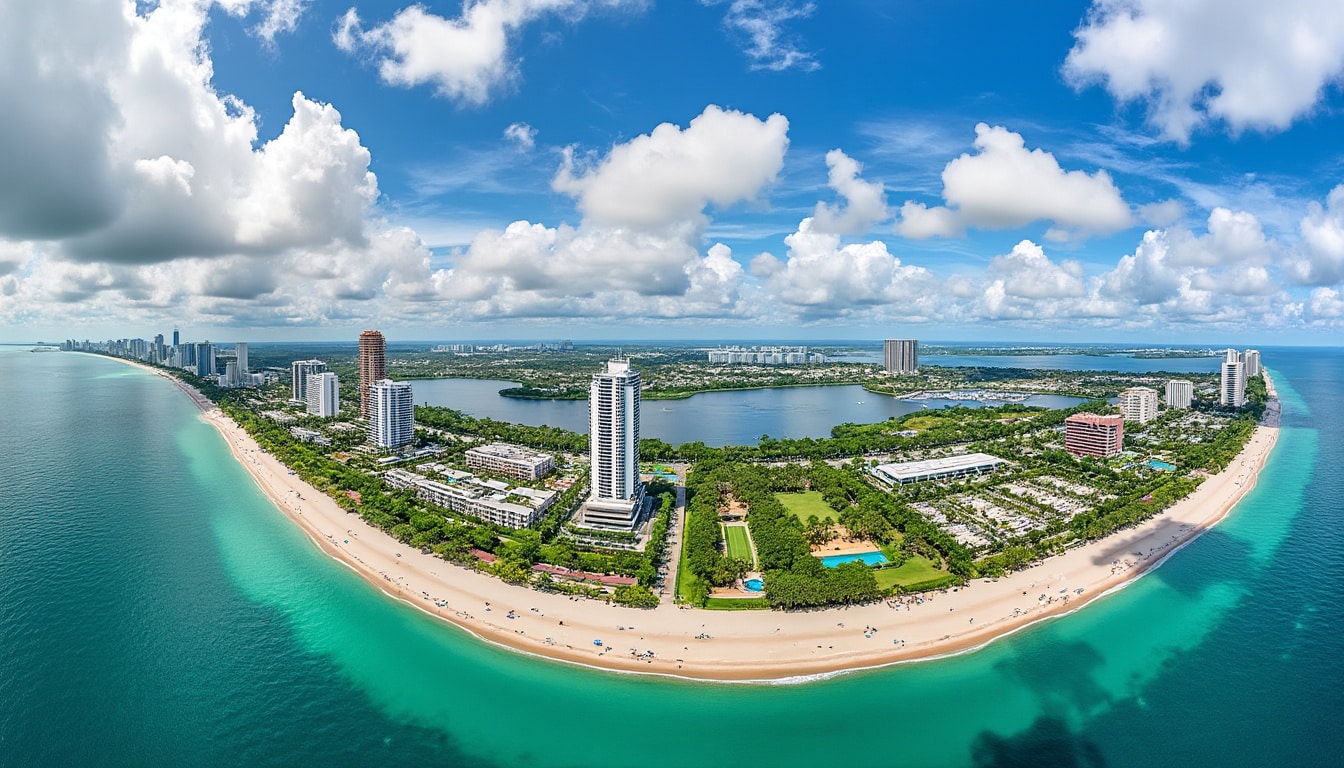When planning a trip to Fort Lauderdale, understanding the weather is crucial to ensure that one’s visit is perfectly timed with favorable climate conditions. This vibrant city, nestled along Florida’s southeastern coast, boasts of a typical tropical monsoon climate. Known for its sun-kissed beaches and bustling nightlife, Fort Lauderdale captivates both tourists and locals throughout the year.
Fort Lauderdale in January: Cool Breezes and Sunshine
January in Fort Lauderdale is a time when the city experiences some of its coolest temperatures. During this month, the average temperatures range from a high of 73°F (22.8°C) to a low of 64.2°F (17.9°C). While this might not be the typical winter chill experienced further north, it offers a pleasant respite from the blazing summer sun, making it a perfect getaway for those seeking milder weather.
One can typically expect around 10.5 hours of daylight, allowing ample opportunity to explore the outdoors. Despite its cool climate compared to the rest of the year, Fort Lauderdale still receives about 0.67″ (17mm) of rainfall. This ensures that the lush greenery prevalent throughout the city remains vibrant and refreshing.
With the sea maintaining a gentle temperature of around 74.2°F (23.4°C), it’s still quite inviting for those longing for a winter swim. January is also the time when Fort Lauderdale Beach becomes a haven for those looking to escape harsher winters found elsewhere.
In addition to the weather, January offers a series of local events that draw visitors, such as art fairs and music festivals, capitalizing on the fact that it is a popular time for tourists. For those who appreciate a little extra daylight, visiting Fort Lauderdale in January means enjoying the sun despite its position closer to the winter months.

For more details about this month, you can explore local resources such as the climate overview or check updates with weather outlets like AccuWeather and The Weather Channel for real-time forecasts and personalized alerts. Travel advisories from these services ensure visitors make the most of their time amidst Fort Lauderdale’s January allure.
February in Fort Lauderdale: Milder Temperatures and Longer Days
February brings a slight warming trend to Fort Lauderdale. Average temperatures during this month see a gentle climb, ranging from approximately 77°F (25°C) to lows of around 60°F (15°C). The balance of warmth without the extreme heat of summer makes February an immensely popular month for tourists and locals alike to indulge in outdoor activities.
With the days lengthening, expect to enjoy up to 11.3 hours of daylight, perfect for extended beach days or exploring the many cultural attractions that Fort Lauderdale has to offer. Relative humidity in February is consistent, resting around 73%, which provides comfort without oppressive heat.
- 🌤️ Average High: 77°F (25°C)
- 🌙 Average Low: 60°F (15°C)
- 🌧️ Rainfall: Approximately 0.55″ (14mm)
- ☀️ Daylight: Up to 11.3 hours
Sea temperatures remain warm, hovering around the inviting mark of 75°F (24°C), perfectly conducive to water sports or simply relaxing by the waves. The National Weather Service and Weather Underground can provide detailed forecasts, ensuring visitors are well-prepared for their beach adventures in February.
The month is also marked by its less dense crowds compared to the bustling summer and spring break periods. This allows for a more relaxed experience, be it while dining at a waterfront restaurant or taking a scenic stroll on the promenade.
For those interested in the intersection of culture and climate, catching the least crowded events in February can be enhanced by following local tips found on Fort Lauderdale Sunset, who outline the costs and experiences available during off-peak months.
March Weather in Fort Lauderdale: Transition into Spring
March marks the transition from winter to spring in Fort Lauderdale, with temperatures beginning to rise notably. The average highs reach about 79°F (26°C), with lows not straying much below 62°F (17°C). This month is synonymous with the onset of increasingly warmer days and the first glimpses of the bustling spring break season.
Rainfall in March is slightly more prominent than in previous months, measuring about 0.51″ (13mm). However, these brief showers do little to dampen the overall warmth and vibrancy of the city, especially with daylight hours now stretching up to 12 hours.
As March progresses, the sea warms further, reaching appealing temperatures of around 76°F (24°C). It’s a time when the city’s beaches begin to see more activity, so travelers looking to experience Fort Lauderdale before the crowded peak should plan their visits earlier in the month.
| 📅 Day | 🌡️ Temperature (°F) | 🌧 Rainfall (inches) | 🌊 Sea Temperature (°F) |
|---|---|---|---|
| Typical March | High: 79°F, Low: 62°F | 0.51″ | 76°F |
For continued updates throughout March, use apps like WeatherBug or visit Fort Lauderdale’s weather page for additional insights and recommendations on balancing sunshine adventures with the unexpected showers.
April Showers in Fort Lauderdale: A Precursor to Summer
In April, Fort Lauderdale fully transitions into the warmth of the coming summer months. During this time, average temperatures hover between 83°F (28°C) and lows of 67°F (20°C), creating inviting conditions for all manner of outdoor explorations and festivities.
April showers become more frequent, characteristic of the tropical climate that Fort Lauderdale is renowned for. Rainfall averages about 1.65″ (42mm), yet the nearly 13 hours of daylight provide ample time to enjoy recreational activities both on land and at sea.
- 🌬️ Average High: 83°F (28°C)
- 🌜 Average Low: 67°F (20°C)
- 🌧️ Rainfall: 1.65″ (42mm)
- 🌞 Daylight: Nearly 13 hours
The sea remains warm and inviting at about 77°F (25°C), perfect for those looking to participate in water sports or relax on the beach. Fort Lauderdale in April becomes a haven for beach-lovers and festival enthusiasts, with a notable increase in cultural events and music festivals geared towards celebrating the warm weather.
With helpful insights from platforms like Dark Sky, MeteoGroup, and Climacell, visitors can effortlessly keep track of April’s weather shifts to better plan their itineraries.
May: Summer’s Dawn in Fort Lauderdale
May in Fort Lauderdale signals the advent of summer in every sense of the word. The city basks in sunshine with temperatures climbing between 86°F (30°C) and lows of 72°F (22°C). This warmth, combined with an increase in daylight to about 13.4 hours, indicates the start of the peak tourist season.
Rainfall in May remains considerable, with a monthly average of 1.65″ (42mm), largely because of the increasing heat and humidity. Despite this, the substantial daylight hours and warm sea temperatures, which reach up to 80°F (27°C), create excellent conditions for beach days.
As the city lights up with an array of events ranging from oceanfront concerts to food festivals, May becomes a pivotal month for tourism and local revelry. Beef up your travel plans with data from NOAA and Weather.com, ensuring you can seamlessly navigate Fort Lauderdale’s vibrant scene.
Both visitors and locals anticipate May’s combination of cultural richness and climatic appeal. It’s a period when Fort Lauderdale truly comes to life, offering something captivating for every type of traveler. Further insights into the impact of this weather on the city’s energy can be found on the warm climate overview page for Fort Lauderdale.
FAQ – Fort Lauderdale Weather
- 🌦️ How does the summer monsoon affect travel? The summer monsoon brings increased rainfall, making spontaneous outdoor activities tricky. Checking platforms like The Weather Channel helps plan around rain showers.
- 🌞 What are Fort Lauderdale’s best months for clear skies? Visit between January and March for low rainfall and pleasant temperatures, as confirmed by AccuWeather and Weather Underground.
- 🌊 Is Fort Lauderdale always warm enough for swimming? Yes, the sea remains warm year-round, ensuring enjoyable swimming temperatures even during winter months.
- 📅 What’s the rainiest month? August typically sees the highest rainfall, with statistics accessible via NOAA’s detailed weather reports.
- 🧳 Do I need to pack rain gear for Fort Lauderdale? Given the city’s tropical climate, carrying light rain gear is advisable whenever visiting.

Climate & Weather in Fort Lauderdale
Fort Lauderdale, a gem on Florida’s eastern coastline, boasts a tropical rainforest climate where the sun shines brightly nearly all year round. A favored destination for beach lovers and sun-seekers, this city offers a unique weather experience that enchants visitors…
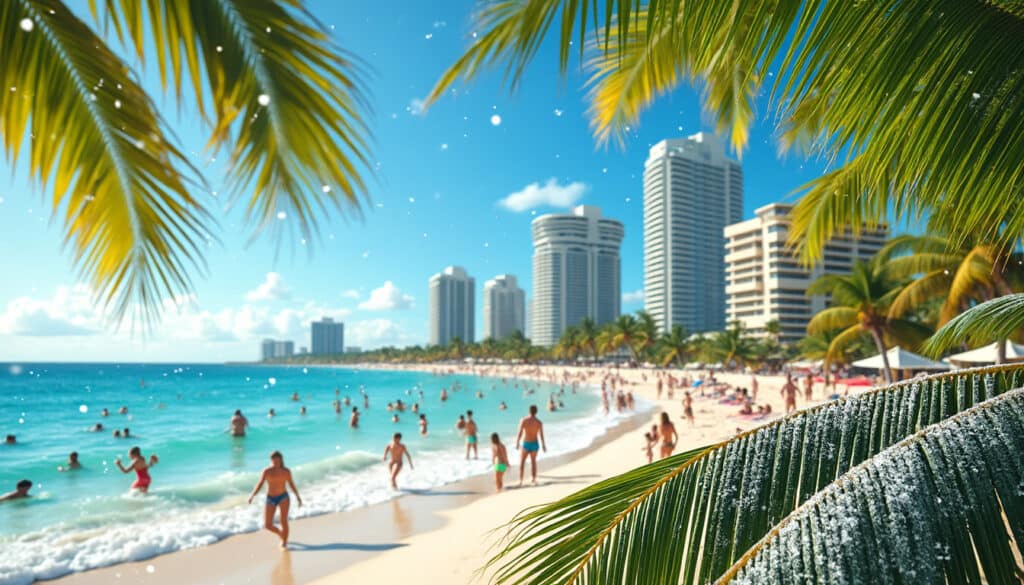
Does it snow in Fort Lauderdale?
Fort Lauderdale, known for its beautiful beaches and sun-soaked landscapes, might not be the first place people associate with snow. With weather patterns changing globally, it’s natural to wonder whether temperatures in this tropical paradise ever drop low enough for…

Flooding and natural risks in Fort Lauderdale
Renowned for its sandy beaches and warm, sunny days, Fort Lauderdale is a city that seamlessly blends leisure with nature’s maritime beauty. However, hidden beneath the sun-dappled waves lies a chronic issue that requires meticulous attention: flooding. Due to its…
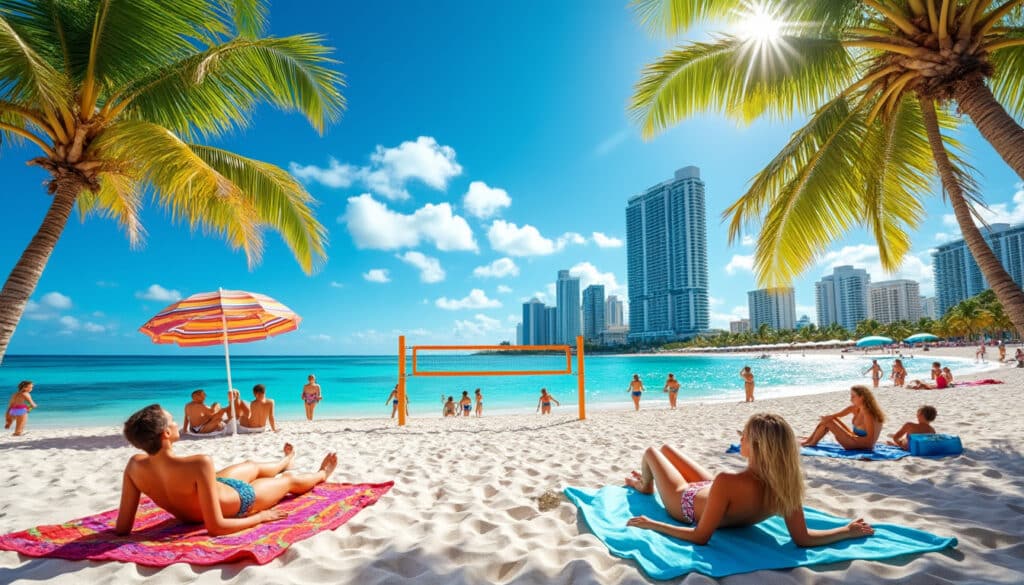
Hot weather in Fort Lauderdale
Fort Lauderdale, with its stunning beaches and vibrant nightlife, is a popular destination for sun-seekers from around the globe. From the bustling Las Olas Boulevard to the tranquil expanses of the Hugh Taylor Birch State Park, there’s plenty to explore…

Fort Lauderdale, often celebrated for its stunning beaches and vibrant nightlife, is also known for its distinctive weather patterns, particularly its humidity. As a coastal city, the feeling of humidity plays an essential role in the everyday life of its…
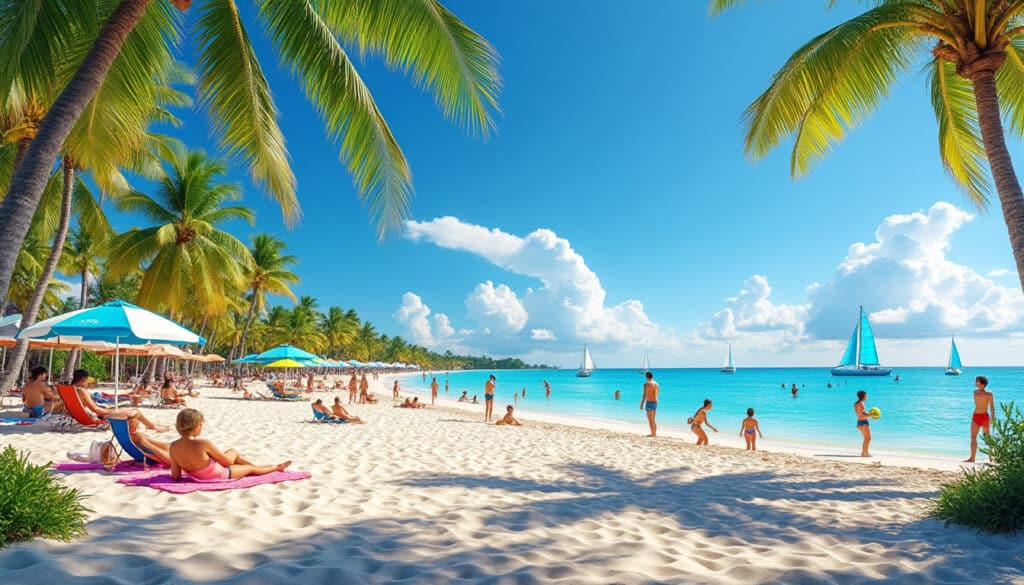
Is Fort Lauderdale warm throughout the year?
Whether basking under the glorious Florida sun or enjoying the gentle ocean breeze, Fort Lauderdale promises a near-constant state of warmth and vacation vibes. This ever-inviting destination, known for its sandy shores and vibrant city life, is more than just…
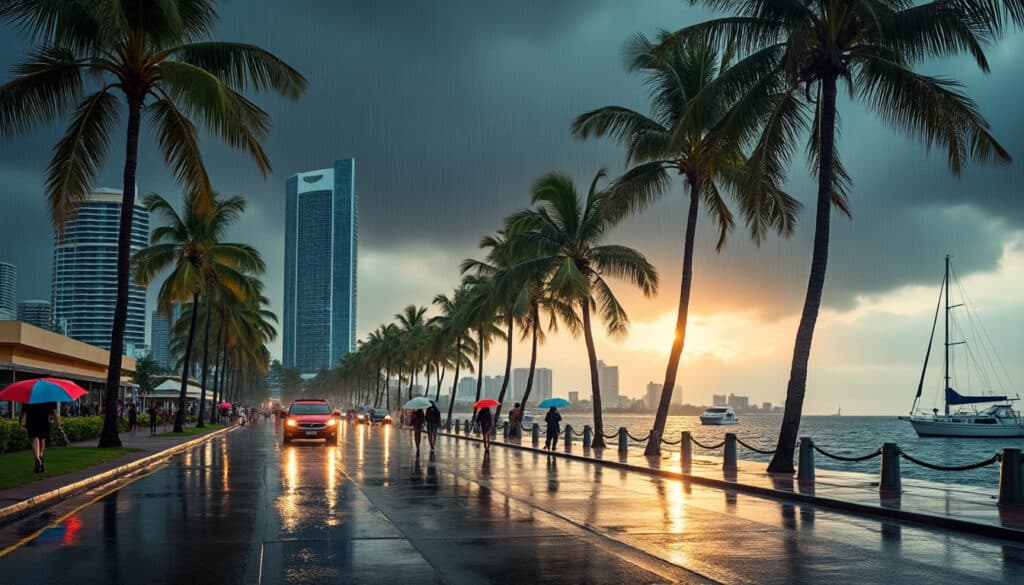
Rain and precipitation in Fort Lauderdale
Exploring the varied and tropical climate of Fort Lauderdale, one might be drawn to its sunshine-drenched beaches and coastal charm. However, rain and precipitation also play a significant role in shaping this vibrant Floridian city’s weather patterns. With a diverse…

Fort Lauderdale is a dream destination where sun, sea, and sand meet vibrant culture and thrilling entertainment. Known for its stunning coastline, this Floridian gem offers endless opportunities for fun and relaxation. But when is the best time to pack…

Sunrise times in Fort Lauderdale
Fort Lauderdale, a coastal gem in Florida, is renowned for its extensive network of sunny beaches and vibrant city life. Among the many draws to this city is the mesmerizing experience of watching the sun rise over the Atlantic Ocean.…

What is the weather like in Fort Lauderdale?
Located on the southeastern coast of Florida, Fort Lauderdale is a region known for its stunning beaches, canals, and vibrant lifestyle. One of its defining characteristics is its weather—a tropical climate that draws tourists and sun-seekers all year round. As…

Cold weather in Fort Lauderdale
Fort Lauderdale is often associated with warm, sunny weather and beautiful beaches. However, every now and then, Floridians get to experience a surprising twist: a cold spell. When cold fronts move across Fort Lauderdale, temperatures can dip unexpectedly, making residents…

